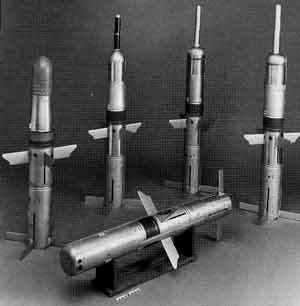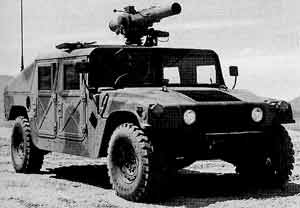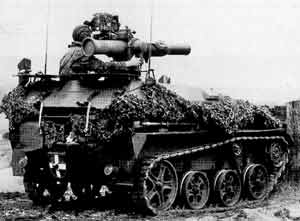| Designation: | TOW BGM-71 |
 |
|---|---|---|
| Manufacturer: | Raytheon Systems Company | |
| Product type: | Weapons & Weapon Systems | |
| Name: | Anti-tank guided missile launcher |
Development/Description
Raytheon Systems .Company (which was previously Hughes Missile Systems Company) BGM-71 A Basic Tube-launched Optically tracked Wire-guided (TOW) Anti-Tank Guided Weapon (ATGW) entered operational service with the US Army in 1970 for use from ground, vehicle and helicopter mounts.
It is fitted with Command to Line Of Sight guidance (CLOS) and all the gunner has to do is to keep the cross-hairs of his sight on the target until the missile impacts.
In 1976, production was switched from the BGM-71A round to the BGM-71 B extended-range basic TOW variant and then again in 1981 to the BGM-71C Improved TOW which has an enhanced copper lined warhead capable of defeating the Soviet armour technology that was being fielded at the time.
This involved the fitting of a 127 mm calibre warhead with a 26b mm long telescopic nose probe fuze system that pops out when the missile is in flight to provide the optimum standoff penetration capability to the missile's shaped charge. The second phase of the warhead improvement programme, the BGM-71 D TOW-2 missile, was introduced in 1983 with a heavier 152 mm calibre copper lined warhead, a 345 mm long telescopic nose probe, improved and countermeasures hardened digital guidance and a new propulsion system.
However, in order to defeat tanks fitted with Explosive Reactive Armour (ERA) blocks, the US Army started an upgrade programme in December 1984 and fielded the BGM-71 E TOW-2A variant in 1987. This has an improved direct attack warhead which incorporates a small shaped charge into the extendable nose probe of the TOW-2 to cause a premature explosion in any ERA block it hits so that the main copper lined warhead charge remains effective in penetrating the conventional armour plate behind. Additional ballast was added to the aft end of the missile to accommodate the extra weight of the new probe; a redesigned safe-and-arm device and an electronic timing device to provide the necessary delay between the tip and main charges were also added.
Following initial development work started in 1987, it was announced in April 1988 that the now Raytheon Systems Company had been awarded a contract for full-scale development of the BGM-71 F TOW-2B ATGW. The contract, valued at US$35 million, was awarded to the now Raytheon Systems Company by the then US Army Missile Command. The missile entered service in 1991.
The TOW-2B (formerly the TOW lethality improvement programme) is a product improved variant with an Overflight Top Attack (OTA) capability. It is fitted with two downward sequentially fired Aerojet Electro Systems tantalum Explosive Formed Projectile (EFP) warheads and the Thomson-Thorn Missile Electronics dual-mode active optical laser profilometer and magnetic sensor fuzing device (see FITOW variant later) in a redesigned forebody ahead of the rocket motor unit.
The warheads are aligned in parallel so that they provide independent shot lines. An advanced guidance programme has been developed which is automatically initiated as the TOW-2B round leaves the launch tube. The gunner still places his cross-hairs on the target but the missile is now commanded to fly at a set height above the line of sight so that OTA can occur.
Under contract to Missile Command, the now Raytheon Systems Company has completed development of a wireless command link for the TOW ATGW. Successful firing trials of this version, known as TOW-2N, were carried out at Redstone Arsenal in Huntsville, Alabama, in mid-1988. Instead of using fine steel wires that pay out from two bobbins in the back of a conventional TOW missile, guidance commands were sent from the launch station to the missile via a secure millimetre-wave datalink.
The test programme used TOW-2 missiles modified to include the millimetre-wave receiver, antenna and processor in place of the wires and bobbins. The TOW-2 launcher was modified with a millimetre-wave transmitter and antenna and an additional electronics card. The weight of the wireless hardware in the missile was less than that of the wires and bobbins. A production version would incorporate a larger rocket motor and would have a typical engagement range of 5,000 m. As of mid-1999, there were no plans for this version of TOW to enter production.
Under contract to the British Ministry of Defence Thomson-Thorn Missile Electronics has developed the UK Further-Improved TOW (FITOW) which uses a Thomson-Thorn Missile Electronics fuze and Royal Ordnance top attack warheads. This was developed for the Lynx helicopters of the Army Air Corps and has been retrofitted to existing missiles.
The FITOW variant uses a Thomson-Thorn Missile Electronics forebody with a dual-mode fuzing device. This comprises an active optical laser altimeter that measures the profile of the terrain being overflown and fires two near-vertically aligned shaped charge warheads into the top of the target when it detects the profile of a tank and the onboard magnetometer sensor confirms the presence of a large metallic mass (so as to prevent unwanted firings against decoys and so on). The target vehicle can be approached by the missile from any direction. Raytheon Systems Company has also modified the missile guidance loop so that FITOW flies above the gunner's line of sight in order to permit the OTA flight profile.
For fitting to 127 mm calibre warhead TOW variants, Israel Military Industries has developed a replacement tandem warhead unit that is specifically designed to defeat ERA-equipped tanks. A spring-loaded retractable probe is fitted which extends upon launch. It has a precursor PBX HE charge at its tip which is triggered at the optimum standoff distance by an active laser proximity fuze. This 'neutralises' the overlying protective ERA layer and allows the main protected warhead charge, comprising a precision shaped PBX HE charge and copper liner, to explode and penetrate the tank's actual armour plate located beneath.
TOW has seen extensive combat use in a number of conflicts including Angola, Chad, the 1973 Yom Kippur War, Lebanon, the Iran-Iraq War, the Thai-Cambodian border skirmishes, the Thai-Laotian border skirmishes, the Vietnam War and the 1990-91 Gulf War.
In the latter conflict, a number of countries used the TOW system. The US Army/US Marine Corps alone shipped some 50,000 rounds into the theatre of operations, of which over 3,000 (primarily TOW-2 and TOW-2A) were fired at a wide variety of targets varying from T-72 MBTs to machine gun emplacements and individual snipers.
In the Battle of Khafji, counterattacking Saudi Arabian TOW gunners alone destroyed 46 armoured vehicles, whilst assisting US Marine Corps Cobra helicopters helped destroy a further 20 tanks and APCs.
Late in 1996, the now Raytheon Systems Company stated that there were over 15,000 TOW launchers (including helicopters) deployed in the world with current production models being the TOW-2A and TOW-2B. Total production has now passed 600,000 missiles and is scheduled to continue through the remainder of this century.
The TOW BLAAM (Bunkers Light Armour and Masonry) warhead has been developed to the prototype stage by Raytheon Systems Company and Aerojet and has been optimised to defeat targets behind concrete and masonary walls, and in bunkers, at extended ranges using existing TOW launchers. The warhead is retrofittable to existing TOW missiles with no changes required to the guidance system.
The US Army holds stock of TOW Improved TOW and TOW 2 for contingency and training only. TOW-2A and TOW-2B are now the only operational tactical rounds.
The Follow-On To TOW (FOTT) programme has been cancelled (Jane's Armour and Artillery Upgrades 1998-99 pages 81 to 82). As an interim solution a TOW Technology Insertion programme is now being studied which will be of the fire-and-forget type.
BGM-71A/B production complete. In service with Bahrain, Canada, Chad, Colombia, Denmark, Ethiopia, Germany, Greece, Iran, Iraq, Israel,.Italy, Jordan, Kenya, South Korea, Kuwait, Lebanon, Luxembourg, Morocco, Netherlands, Norway,. Oman, Saudi Arabia, Somalia, Spain, Taiwan, Thailand, Tunisia, UNITA movement, the UK, the USA and Yemen.
BGM-71C production essentially complete. In service with Botswana, Egypt, Finland (as M83), Greece, Israel, Italy, Japan, South Korea, Kuwait, Netherlands, Pakistan, Saudi Arabia, Spain, Sweden (as Rb55), Thailand, Turkey, the UK and the USA.
BGM-71D in production. In service with Bahrain, Belgium, Canada, Denmark, Egypt, Finland, Germany, Italy, Netherlands, Norway, Pakistan, Portugal, Saudi Arabia, Singapore, Spain, Sweden, Switzerland (licence-built), Thailand, Turkey and the USA.
BGM-71E in production. In service with the USA, Canada, Italy and several other countries.
BGM-71F in production. In service with Italy and the USA.
Tracked Desert Warrior (two single-tube turret launchers - Kuwaiti Army)
Tracked M2/M2A1/M2A2 (twin-tube turret launcher - 3,682 delivered to US Army, 400 to Saudi Arabia) Being upgraded with improved Bradley Acquisition system (IBAS).
Tracked M3/M3A1 (twin-tube turret launcher - US Army)
Tracked M113 series (single-tube launcher - Danish, Egyptian, Greek, Israeli, Italian, Portuguese, Somali, Thai, Tunisian, Turkish and US armies)
Tracked M901 (twin-tube ITVturret launcher- Egyptian, Greek, Jordanian, Kuwaiti and Pakistani armies)
Tracked VCC-1 (twin-tube ITV turret launcher - Saudi Arabian Army)
Tracked Jaguar 2 (single-tube launcher- German Army)
Tracked YPR-765 PRAT (twin-tube ITV turret launcher-Royal Netherlands and Egyptian armies)
Tracked NM142 (twin-tube Kvaerner-Eureka turret launcher - Norwegian Army, this version is also in service with Canadian Forces on the M113A1 APC and with the
Turkish Army on modified Armored Infantry Fighting Vehicle chassis)
Tracked Pvrbv551 (single-tube launcher-Swedish Army)
Tracked AIFV (single-tube launcher - Taiwanese Army)
Tracked M42 Mod (single-tube launcher - Taiwanese Army)
Tracked Wiesel Airportable Vehicle (single-tube launcher- German airborne troops)
8x8 LAV(AT) (twin-tube ITV turret launcher - Saudi Arabian National Guard and US Marine Corps)
6x6 MOWAG Piranha (twin-tube Kvaerner-Eureka turret launcher - Swiss Army)
4x4 RBY Mk-1 (single-tube launcher - Israeli Army)
4x4 LAV-150 (single-tube launcher - Saudi Arabian
National Guard and Taiwanese Army) 6 x 6 M8 Mod (single-tube launcher - Colombian Army).
Tracked Dardo Hitfist (on order for Italian Army) (one TOW launcher either side of turret)
Tracked BWP 2000 (one TOW launcher either side of turret -tested by Polish Army).
|
||||||||
|
|||||||||
Related Articles |
|
Military-Industrial Company LLC completed preliminary tests of the Boomerang armored vehicle (06.12.2019) |
|
U.S. Marine Corps orders more Amphibious Combat Vehicles (11.11.2019) |
|
Raytheon, Rheinmetall form joint venture for US Army combat vehicle competition (02.10.2019) |
|
IVECO DEFENCE VEHICLES AWARDED CONTRACT TO DELIVER A NEW GENERATION OF MEDIUM MULTIROLE PROTECTED (24.09.2019) |
|
CZECH REPUBLIC SIGNED THE ACQUISITION CONTRACT FOR 62 TITUS (30.07.2019) |
|
The Dutch armed forces select Rheinmetall to modernize their Bergepanzer 3 Büffel (17.05.2019) |
|
Krauss-Maffei Wegmann supports the modernization of the Hungarian Army (22.12.2018) |
|
KMW and Nexter join forces on Main Ground Combat System (21.06.2018) |
|
Nexter, a company of KNDS, presents its strategy in the field of robots (18.06.2018) |
|
Huge potential for KONGSBERG in Qatar (14.03.2018) |
|
ATI Announces New Long-Term Agreements With General Dynamics Land Systems (30.01.2018) |
|
HDT Global Hunter WOLF Awarded Phase II SMET Contract (10.01.2018) |
|
Lockheed Martin Autonomous Driving System Tops 55,000 Miles in Extended Army Testing (30.11.2017) |
|
Stratom XR-P Demonstrates Autonomous Loading, Unloading From MV-22 (16.10.2017) |
 |
 |
 |



























